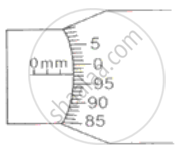Advertisements
Advertisements
प्रश्न
The main scale reading while measuring the thickness of a rubber ball using Vernier caliper is 7 cm and the Vernier scale coincidence is 6. Find the radius of the ball.
उत्तर
The reading of a Vernier caliper is given by:
Measured Length = Main Scale Reading (MSR) + (Vernier Coincidence (VC) × Least Count (LC))
Given:
- Main Scale Reading (MSR) = 7 cm
- Vernier Coincidence (VC) = 6
- Least Count (LC) is generally 0.01 cm (assuming typical calipers).
Step 1: Calculate the Measured Length
Measured Length = 7 + (6 × 0.01)
Measured Length = 7 + 0.06 = 7.06 cm
Step 2: Find the Radius
The diameter of the ball is 7.06 cm, so the radius is:
`"Radius" = "Diameter"/2 = 7.06/2 = 3.53 cm`
The radius of the ball is 3.53 cm.
APPEARS IN
संबंधित प्रश्न
The wavelength of light of a particular colour is 5800 Å.
Express it in metre.
A boy uses a vernier callipers to measure the thickness of his pencil. He measures it to be 1.4 mm. If the zero error of vernier callipers is +0.02 cm, what is the correct thickness of the pencil?
State the formula for calculating length if:
The reading of the main scale is known and the number of vernier scale divisions coinciding with the main scale is known.
For what range of measurement is micrometre screw gauge used?
State the formula for calculating the least count of screw.
How the backlash error is avoided?
In the following figure, the pitch of the screw is 1 mm. Calculate:
(i) the least count of screw gauge and
(ii) the reading represented in the figure.

State whether the following statement is true or false by writing T/F against it.
The diameter of a wire can be measured more accurately by using vernier calipers than by a screw gauge.
What is the least count in the case of the following instrument?
Metre scale
